A CEO's Guide to LinkedIn Profiles

Introduction
In today's digital age, a CEO's personal LinkedIn profile is more than just a resume; it is a powerful tool for driving sales, enhancing credibility, and increasing visibility for the company. A well-crafted CEO LinkedIn profile can act as a dynamic sales funnel, attracting potential clients, investors, and top talent. It builds credibility and authority in the industry, positioning the CEO as a trusted voice and leveraging the executive hiring thought leadership advantage linkedin to attract high-level professionals.
Research shows that most people who work with, for, or alongside a CEO will research their profile before engaging. This means a strong LinkedIn presence can make a significant difference in hiring, fundraising, and overall business development efforts. A compelling profile not only showcases the CEO's achievements and vision but also reflects the company's values and mission.
This comprehensive guide offers insights and strategies to help CEOs optimize their LinkedIn profiles, based on our experience working with over 150 CEOs. By following these recommendations, you can transform your LinkedIn presence into a robust component of your content marketing strategy, driving meaningful engagement and tangible business results. Whether you are looking to enhance your network, attract investors, or hire top talent, a strategically designed LinkedIn profile is essential.
1. Banner Image
Description:
A CEO's LinkedIn banner image is a crucial element in establishing a strong first impression. As the most prominent visual component of a LinkedIn profile, the banner image sets the tone for the visitor's perception of the CEO and their company. It should convey credibility and professionalism while also succinctly communicating the CEO's value proposition within three seconds. This "3-second rule" is vital because visitors quickly form judgments about whether they want to engage further.
Using a professional image or background in the banner ensures that the profile appears polished and authoritative. The inclusion of the company’s logo helps reinforce brand recognition, which is essential for CEOs looking to enhance their company’s visibility and credibility. Additionally, the banner image should succinctly explain the CEO's value in ten words or less. This brief, impactful statement helps visitors immediately understand what the CEO offers, making it easier for them to decide to connect or follow.
In essence, the banner image is not just a decorative element; it is a strategic tool that plays a significant role in personal branding. It encapsulates the CEO's professional persona and the company's ethos, making it an indispensable part of an effective CEO LinkedIn profile.
Recommendation:
Your banner image should convey credibility and pass the “3-second rule,” meaning visitors should understand why they should work with you in just 3 seconds.
Key Points:
- Use a professional image or background.
- Include your company’s logo.
- Explain your value in 10 words or less.
Examples:






2. Profile Photo
Description:
In the realm of professional networking, a CEO’s LinkedIn profile photo holds significant weight. It serves as the digital face of the leader and, by extension, the company. Many CEOs, however, mistakenly use outdated or unprofessional photos, inadvertently undermining their credibility and their initial impression. Given that LinkedIn is a platform where first impressions matter immensely, having a clear and professional profile photo is crucial.
Your profile photo is not just a static image; it represents you in all LinkedIn activities. Whether you are commenting on a post, engaging with content, or publishing your own updates, your photo is constantly visible. This makes it essential to choose a photo that is both recent and professional. A good rule of thumb is to ensure that your face makes up at least 60% of the photo. This close-up view helps others recognize you and creates a more personal connection.
Looking directly at the camera in your photo conveys confidence and approachability, important traits for any leader. Additionally, your photo should only include you—no other people should be visible. This keeps the focus squarely on you and avoids any potential confusion about the profile's owner.
Recommendation:
Your profile photo represents you in all LinkedIn activities, making it crucial to have a clear and professional image.
Key Points:
- Your face should make up at least 60% of the photo.
- Look directly at the camera.
- No other people should be visible in the photo.
Examples:

3. Headline
Description:
In the fast-paced world of professional networking, a CEO's LinkedIn headline is more than just a job title; it is a strategic tool for capturing attention and communicating value. Most CEOs only list their current role in their headline, missing out on a significant opportunity to engage and attract their audience. Given that this headline appears every time the CEO comments on a post, it receives a substantial amount of visibility. Therefore, it is worth investing time and effort to craft a headline that functions as an elevator pitch, increasing the likelihood that someone will understand their value and reach out to them.
A well-crafted LinkedIn headline should be succinct, yet informative. It should start with the CEO's current role, ensuring that their professional identity is immediately clear. However, this is just the beginning. To maximize impact, the headline should also include a brief tagline or short description that highlights what they do and what sets them apart. This additional context can pique the interest of potential clients, partners, or talent who might otherwise scroll past a simple job title.
Using a visual breakpoint, such as a vertical bar (|) or dash (–), between the job title and the tagline helps to create a clean and readable format. This separation makes the headline easier to digest and more visually appealing, ensuring that key information stands out.
Recommendation:
Your headline should be succinct, including your current role and a brief tagline about what you do.
Key Points:
- Your current role should be first.
- Include a tagline or short description.
- Use a visual breakpoint (e.g., | or —) between these items.
Examples:

4. Premium Custom Button
Description:
Many CEOs are unaware of the powerful opportunity LinkedIn offers to drive traffic to their company website directly from their personal profile. This feature is a valuable tool for enhancing online visibility, generating leads, and fostering deeper engagement with your audience. By strategically utilizing LinkedIn's traffic-driving capabilities, CEOs can significantly boost their company’s digital footprint and influence.
For those who regularly publish content on LinkedIn, the Premium custom button is an essential feature. This button allows you to direct traffic from every post or comment you make, guiding your audience seamlessly to your website. By consistently driving traffic through engaging content, you can increase your website’s visitor count, enhance brand awareness, and potentially convert viewers into clients or partners. This approach ensures that your LinkedIn activities are not only building your professional network but also actively contributing to your business goals.
Even if you are not a frequent content publisher, you can still leverage LinkedIn to drive traffic to your website by including a link in your profile. This ensures that anyone who views your profile can easily access your company’s website, making it a straightforward yet effective method to increase site visits. By integrating these strategies into your LinkedIn presence, CEOs can maximize the platform’s potential to support their company’s growth and success.
Recommendation:
LinkedIn allows you to drive traffic to a website from your profile or posts. Regular content publishers should use the Premium custom button to direct traffic effectively.
Key Points:
- Use the Premium custom button if you publish content weekly.
- If not, link to your company website from your profile.
Examples:
5. Featured Section
Description:
Many CEOs overlook the potential of the Featured Section on their LinkedIn profile, missing a crucial opportunity to build credibility and demonstrate expertise. The Featured Section is a prominent area on your profile that allows you to showcase various types of media, including articles, videos, LinkedIn posts, and images. Given its size and visual impact, this section stands out significantly, making it an ideal space to highlight your achievements and thought leadership.
The Featured Section is particularly valuable because it allows you to present your most impressive and relevant content directly to your profile visitors. By displaying articles written about you or your company, you can instantly convey authority and trustworthiness. These articles act as third-party endorsements that enhance your professional reputation. Additionally, including videos of your presentations or successful LinkedIn posts can provide dynamic proof of your expertise and communication skills. Videos, in particular, can engage visitors more effectively, offering a glimpse into your personality and leadership style.
By thoughtfully curating the content in the Featured Section, CEOs can effectively use this space to tell a compelling story about their professional journey and the value they bring to their industry. This not only helps in building a strong personal brand but also enhances the overall perception of their company, driving more meaningful connections and opportunities on LinkedIn.
Recommendation:
The Featured section allows you to showcase videos, articles, LinkedIn posts, or images that build your credibility.
Key Points:
- Display articles written about you or your company.
- Include videos of presentations or successful LinkedIn posts.
Examples:


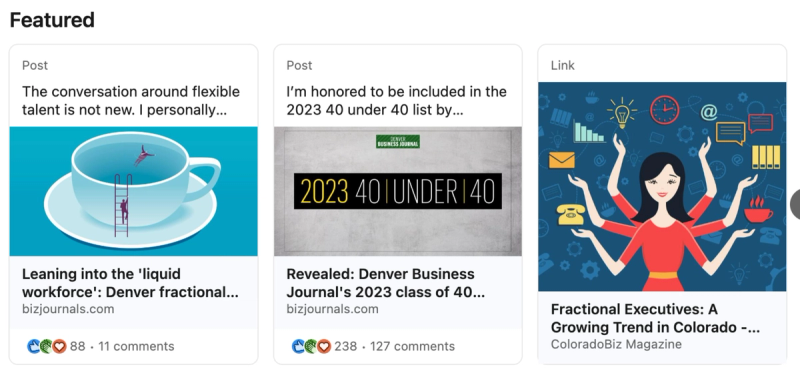
6. About Section
Description:
The About Section of a CEO's LinkedIn profile is a critical component that often goes underutilized. Many CEOs fall into the trap of using this space for a brief, third-person description of their expertise, missing a golden opportunity to truly connect with their audience. Instead, this section should be a powerful narrative that conveys their personal and professional journey, their company's mission, and the impact they are making. It’s the perfect place to articulate the WHY behind their actions, engaging potential customers, employees, investors, and other stakeholders on a deeper level.
A well-crafted About Section goes beyond a simple resume blurb. It should be skimmable and engaging, using bullets and line breaks to enhance readability, especially for mobile viewers. By sharing what you do and, more importantly, why you do it, you can create a compelling story that resonates with your audience. This approach not only showcases your credibility but also humanizes your profile, making it more relatable and inspiring trust.
Moreover, describing your company’s activities, achievements, and vision in this section can significantly boost your profile’s impact. Highlight the results you’ve seen and the value your company offers, making a strong case for why potential customers, employees, or investors should engage with you. By telling a compelling story that combines personal and corporate narratives, CEOs can effectively sell both themselves and their companies, leveraging the full potential of their LinkedIn profile to drive meaningful engagement and opportunities.
Recommendation:
The About section is your space to talk about your "WHY," share your company's story, and your professional journey. Make it scannable and engaging.
Key Points:
- Use bullets and line breaks for optimal readability.
- Share what you do and, critically, why you do it.
- Tell a compelling story that blends personal drive with company impact to showcase credibility and build connection.
Examples:
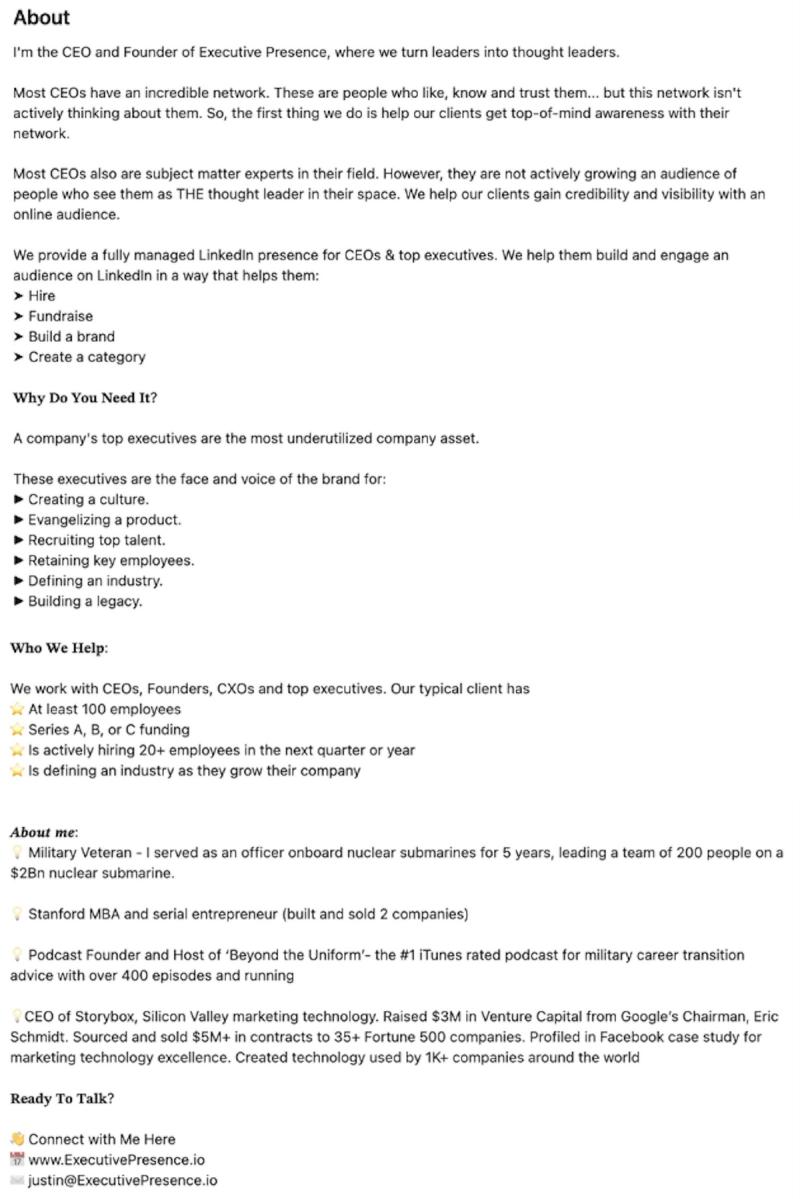
7. Experience Section
Description:
The Experience section of a CEO's LinkedIn profile, particularly the description of their current company, is a pivotal element that can significantly enhance their professional presence. Many CEOs make the mistake of only listing their company name and title, thereby missing a valuable opportunity to provide deeper insights into their business and its accomplishments. By optimizing this section, CEOs can effectively communicate what their company does, the results it has achieved, and why stakeholders should be interested.
A well-detailed Experience section serves multiple purposes. Firstly, it showcases the CEO’s leadership and the company’s impact in the industry. Including a concise description of the company’s activities, mission, and key achievements helps paint a comprehensive picture for anyone visiting the profile. Success metrics, such as revenue growth, market share, or notable projects, add tangible proof of the company’s capabilities and successes, thereby boosting credibility.
Additionally, incorporating images or media can make this section more engaging and visually appealing. Photos of significant events, product launches, or company milestones can capture attention and convey a dynamic, thriving business environment. Highlighting previous positions and linking them to the current role can also demonstrate the CEO’s career progression and the accumulated experience that they bring to their current position.
Recommendation:
Showcase your relevant roles and key achievements concisely in the Experience section.
Key Points:
- Include a description for your current company and its success metrics.
- Add images to stand out.
- Highlight previous positions as part of your current story.
Examples:
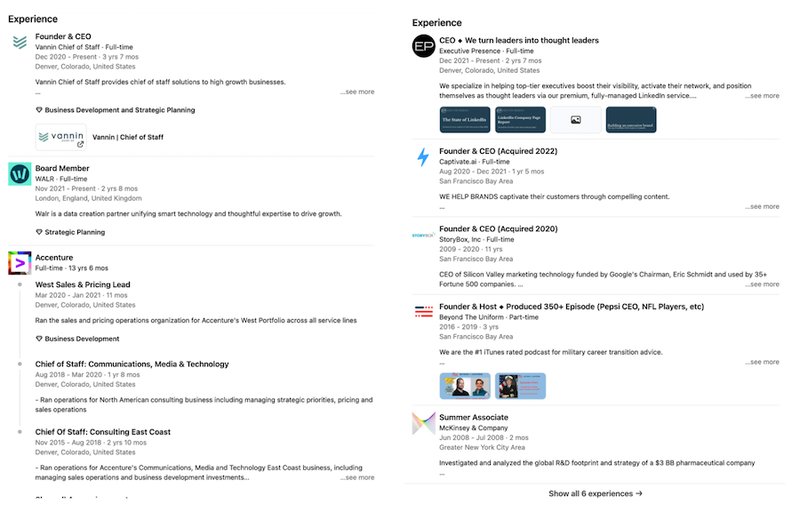
8. Education Section
Description:
The Education section on a CEO’s LinkedIn profile is often underutilized, typically reduced to a simple list of degrees and institutions. However, this section offers a unique opportunity to humanize the CEO and provide a deeper understanding of their background and values. By showcasing not only educational qualifications but also extracurricular activities, leadership roles, and achievements, CEOs can present a more well-rounded and engaging professional profile.
Detailing involvement in clubs, extracurricular activities, and leadership opportunities can significantly enhance the Education section. These experiences demonstrate initiative, teamwork, and leadership skills—qualities that are essential for a successful CEO. For instance, mentioning participation in a debate club, leading a student organization, or receiving academic awards can highlight a CEO’s proactive and achievement-oriented nature. These details make the profile more relatable and can foster a connection with viewers who may share similar experiences or values.
Additionally, including success metrics and specific achievements during their educational journey can further bolster a CEO’s credibility. Highlighting notable projects, research, or internships can showcase the practical application of their education and its relevance to their current role. This not only adds depth to their profile but also provides tangible evidence of their capabilities and commitment to excellence.
Recommendation:
Showcase degrees, certificates, and other educational achievements comprehensively. Include details that highlight your involvement and impact.
Key Points:
- Add information about clubs, extracurricular activities, and success metrics.
Examples:
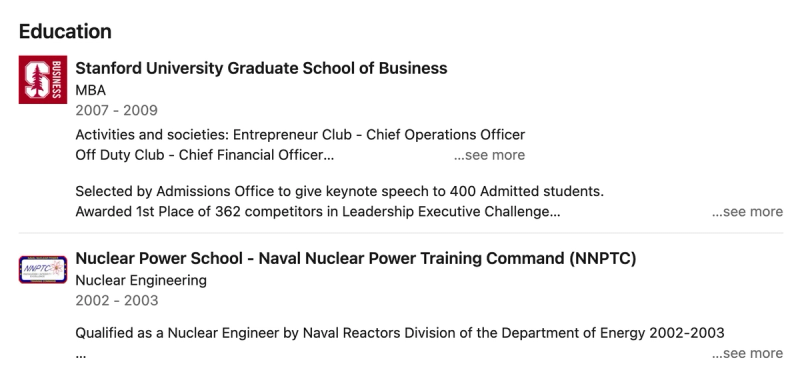
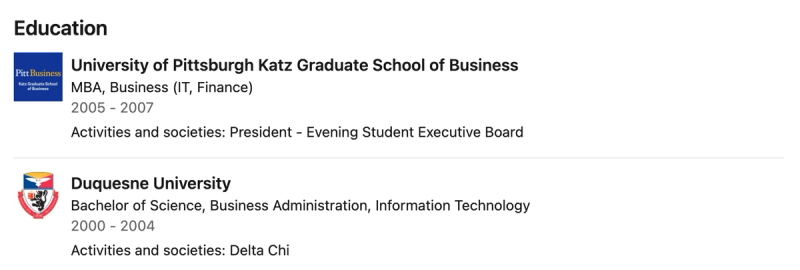
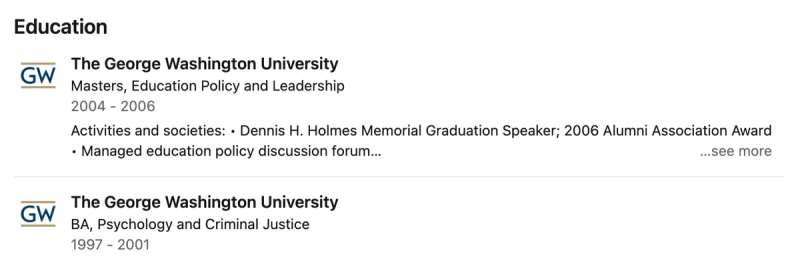
Conclusion
A well-optimized LinkedIn profile is essential for CEOs looking to enhance their credibility, authority, and visibility. By following these strategies, CEOs can effectively position themselves as thought leaders and drive meaningful engagement on LinkedIn.
Subscribe for Executive Updates
Go from Leader to Thought Leader
Whether you want to attract new talent, raise capital, launch a product, or establish yourself as a thought leader, we give you the tools you need to make it happen. Let's turn your expertise into influence. Schedule a strategy call today!




